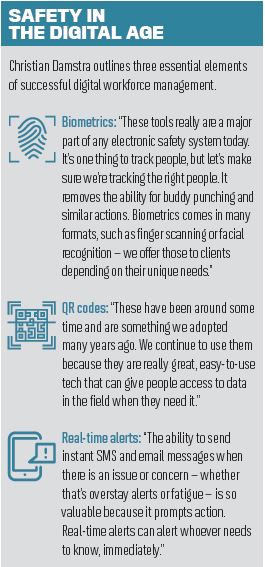
How well do you know your employees? Do you know how many are under your duty of care and whether they have the capabilities they claim? It might be time to shine a light on your workforce

How well do you know your employees? Do you know how many are under your duty of care and whether they have the capabilities they claim? It might be time to shine a light on your workforce
It’s easy to forget amid the significant disruption caused by gig economy workers that certain industries have utilised short-term contractor or contingent workers for eons. Australia’s mining, construction, transport and labour hire industries – and countless others – have long used contractors and subcontractors as a core component of their workforces.
It’s perhaps not surprising that the talent management technology that has been developed to service these workforces in Australia is among the most sophisticated in the world.
An example is Damstra Technology’s fully integrated suite of cloud-based technology for end-to-end workforce management. Developed over the past 16 years, Damstra Technology’s Total Workforce Management System (TWMS) provides a real-time, finger-on-the-pulse insight into a workforce’s capability, credentials, and time and attendance.
“It’s not just an app you download, it’s not a website or piece of software that you buy and continuously update, it’s not a piece of hardware – it’s all of those things connected together to create this fully integrated end-to-end system,” explains Chris Hutchins, COO, Damstra Technology.
Just as critical in a world shaped by gig or contractor workers is verifying that people are who they claim to be, and have the qualifications being sought. Damstra Technology’s TWMS also acts as a document verification service to ensure compliance.
“As a transient or itinerant workforce registers into our system we obtain all of the relevant certifications and credentials, such as licences, trade certificates, etc, depending on the client’s needs and obligations. Our verification service captures all of the relevant dates and details of the certification and skills that have been issued or attained, creating a powerful database of the workforce,” says Hutchins. “What we’re able to offer our clients is a digital way of tracking the capabilities of the workforce. That’s very important from a compliance perspective, especially if you’re trying to ensure the people turning up at your workplace are fit to work and are the right people to do the right job.”
This last point is critical to successful – and safe – workforce management, says Christian Damstra, founder and CEO of Damstra Technology.
“There are plenty of software solutions out there, but at the end of the day software is only as good as the way the software is run. If the inherent processes in an organisation are challenged due to staffing levels or financial levels, that’s where we can step in and lift this entire compliance headache off an organisation. That’s going to save time and money.”

Damstra says a key difference between a permanent employee base and a contingent base is the uncertainty. Many organisations that operate without digital registration processes, he adds, simply do not know how many contractors they employ.
“I’ve seen variations between 30% and 50% of the number – and that goes in both directions,” he says. “I’ve had clients tell me they’ve got 10,000 people, and when you get in and do it they only have 5,000. The fact they don’t know is a major risk for any organisation, and this flows into other statistics too. For example, under many OHS guidelines and laws, organisations must account for lost-time- injury frequency rates; if you don’t know how many hours you’re working across your business, you can’t have accurate rates or reporting, and you don’t know where to look for structural solutions. Those same reports can affect insurance premiums and impact whether or not you win the next job. It’s very important you get this information accurate.”
Central to all this is user experience. Hutchins explains that the company’s underlying approach to user experience is simple: “To take what’s good and enhance it to become great”.
He says Damstra Technology has a full-time user-experience focus, which involves looking at making the company’s processes world class, and turning the huge amounts of data generated by the system into actionable insights.
The in-field actions taken from real-time data can be seen, for example, when a worker produces a failed alcohol test. The supervisor will receive an SMS or email alert straight away and the actionable outcome will occur immediately. Other benefits come from benchmarking industry or sector data, as Damstra explains.
“Data is one thing, but how you use the data is the important part,” he says. “We can implement our system on any client site, and we can have integrated drug testing, alcohol testing, fatigue management and all those things, but if a client is getting five failed alcohol tests in one week, is that good? Maybe they don’t know because, at the end of the day, what is best practice? Because we have such a spread of clients, we can trend-analyse that data and see that, for other companies with a similar number of employees or time punches conducted, those failed alcohol tests are trending down to two per week. Then you know you may have a problem and an opportunity to make your workplace safer.”
Meeting compliance obligations
Most employers – regardless of whether their workforce consists of full-time employees or contractors – have trouble staying on top of compliance training and ensuring they meet ever- changing government regulations, particularly when it comes to health and safety. This has never been more critical in this gig economy where there is no real compliance framework and employers have to try to ensure they remain compliant as best they can.
Again, Damstra Technology has the solution. “Our system allows you to book people into e-learning content and physical classes and keep a record of the results of testing from these training courses or inductions. It means you’ve got a real-time record of who’s been scheduled, who’s done the course, what the results were and any remedial actions taken. Without some sort of digital system in place I would struggle to understand how this can be managed effectively with today’s workplaces,” Hutchins says.
Keeping pace
Taking digital workforce transformation a step further, Damstra Technology is increasingly adding value to clients by engaging in process thinking. For example, the company has been engaged by clients to track, manage and protect not just people but also plant equipment and machinery.
“As long as the gig economy requires people, it will require assets,” says Hutchins.
The normal way a work engagement process would work would be to conduct all the prequalifications and verification of documents up front, before a worker moves through to an on-site familiarisation or to start working; in such a process, documents would be verified, a profile would be created and the worker would receive their ID card.
On a fast-paced construction site time is of the essence, and sometimes front-end loaded processes can’t be used or take too long when a job has to be done. Damstra Technology has therefore rethought the traditional process.
“We’ve changed our system so we can effectively commence the same registration process from a supervisor’s palm of hand, using our mobile app. They can commence registration, grab the required basic credentials to get someone started, and then we follow through on the back end with any pieces of the puzzle that are also equally required but not necessary from day one,” says Hutchins.
“That’s another example of where we’ve innovated by adopting our technology to the real-time, fast-moving demands of the workforce.”